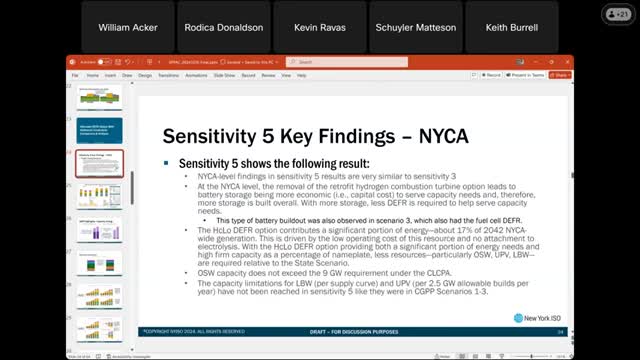Energy Storage Revolutionizes New York's Power Landscape
October 18, 2024 | Department of Public Service, State Agencies, Executive , New York
This article was created by AI summarizing key points discussed. AI makes mistakes, so for full details and context, please refer to the video of the full meeting. Please report any errors so we can fix them. Report an error »

In a recent government meeting, discussions centered on the evolving landscape of energy generation and storage, particularly in relation to New York City's Housing Authority (NYCHA) and the implications of removing hydrogen combustion turbine options. The removal is leading to an increase in battery storage development, which is deemed more economically viable for meeting capacity needs.
The meeting highlighted that this trend aligns with findings from scenario analyses, indicating that battery storage is becoming more cost-effective compared to fuel cells. By 2042, batteries are projected to contribute approximately 17% of the New York Control Area's (NYCA) total generation, driven by their low operating costs and independence from electrolysis processes.
Furthermore, the discussions revealed that the current energy strategy reduces the reliance on offshore wind, utility-scale photovoltaic (UPV), and land-based wind resources, which are not expected to meet the state's ambitious capacity requirements under the Climate Leadership and Community Protection Act (CLCPA). Notably, offshore wind capacity is anticipated to remain below the mandated 9 gigawatts.
The meeting also addressed the assumptions regarding local capacity requirements (LCR) and transmission constraints, confirming that the current model does not utilize a copper sheet approach, which typically allows for more flexible transmission planning. Participants acknowledged the need for further clarification on specific zones, particularly regarding UPV limits in Zone K.
As the meeting progressed, comparisons were made between various sensitivity scenarios, with a focus on how these scenarios relate to the state's overall energy strategy. The consensus indicated that the high capital, low operating capacity model is expected to remain a significant component of New York's energy infrastructure by 2042.
The meeting highlighted that this trend aligns with findings from scenario analyses, indicating that battery storage is becoming more cost-effective compared to fuel cells. By 2042, batteries are projected to contribute approximately 17% of the New York Control Area's (NYCA) total generation, driven by their low operating costs and independence from electrolysis processes.
Furthermore, the discussions revealed that the current energy strategy reduces the reliance on offshore wind, utility-scale photovoltaic (UPV), and land-based wind resources, which are not expected to meet the state's ambitious capacity requirements under the Climate Leadership and Community Protection Act (CLCPA). Notably, offshore wind capacity is anticipated to remain below the mandated 9 gigawatts.
The meeting also addressed the assumptions regarding local capacity requirements (LCR) and transmission constraints, confirming that the current model does not utilize a copper sheet approach, which typically allows for more flexible transmission planning. Participants acknowledged the need for further clarification on specific zones, particularly regarding UPV limits in Zone K.
As the meeting progressed, comparisons were made between various sensitivity scenarios, with a focus on how these scenarios relate to the state's overall energy strategy. The consensus indicated that the high capital, low operating capacity model is expected to remain a significant component of New York's energy infrastructure by 2042.
View full meeting
This article is based on a recent meeting—watch the full video and explore the complete transcript for deeper insights into the discussion.
View full meeting
